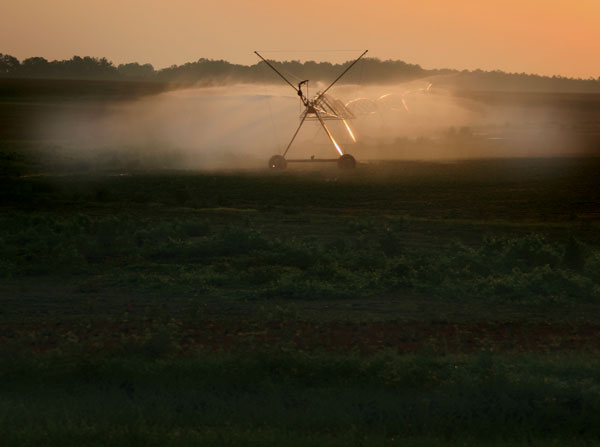
Water issues becoming more commonplace in Southeast agriculture
• In the Southeast, the problem is not how much rainfall, rather how to manage the rain the area gets.• Water quality issues used to drive water policy.• Now, water quantity is becoming a key issue — much as it has been for many years in the western half of the country.
August 2, 2013

Though too much water in the spring and summer may put other moisture issues at bay for a while this year, odds are good that even though the drought that has been officially killed by record-breaking May, June and July rainfall, it will be back.
What crops to plant, how to plant, and what role irrigation will play in future crop production are issues growers in the Southeast are going to have to pay more attention to in the future than they and their predecessors have in the past.
Cotton acreage is down this year in the region, but some who cut acreage to plant wheat in the fall and soybeans in the late spring are now re-thinking that decision.
Though based more on economics than environmental concern, growers are likely to find out the impacts of both too much and too little rainfall before both crops are in the bin.
Many areas of the country that were plagued by drought the past two years are now dealing with too much water.
In the Southeast, the problem is not how much rainfall, rather how to manage the rain the area gets, says North Carolina water expert Bill Holman.
Holman, who is Director of the North Carolina Conservation Fund, says water quality issues used to drive water policy. Now, he says water quantity is becoming a key issue — much as it has been for many years in the western half of the country.
Want the latest in ag news delivered daily to your inbox? Subscribe to Southeast Farm Press Daily. It’s free!
The drought year of 2003, started key players talking about water quantity issues. Then, the back to back drought years of 2007-2008 brought many of these issues to the forefront as states, and even cities and counties, wrangled over water rights.
Water storage is simple solution
One relatively simple solution to water quantity issues is water storage. Unfortunately, there are few water storage facilities in the Southeast and no definitive plans for adding new ones, the North Carolina expert says.
In Raleigh, for example, Holman says the average rainfall of 44-45 inches per year is more than adequate to grow crops. The problem is timing of the rain and how it is dispersed among rural and urban areas.
The future of water in the region, Holman says, swings on four issues:
• Highs and lows in water supply must be better balanced.
• States and other municipalities must be in collaboration, not conflict over rights and usage.
• Utility companies must sell water services, not gallons of water.
• 21st century manufacturers of all water using products must become more efficient.
One trend that is sure to help agriculture, he adds, is toward developing different types of water to sell. Only a small percentage of water use goes for potable water — and that percentage is shrinking in most parts of the country, he says.
Already, small industries and businesses like Duke University, are using catchment facilities to capture rainfall and use it for non-potable sources. Though relatively small in scale, he says, the results so far have been impressive in the reduced water demand Duke University has on the City of Durham.
“I think one change we must see in the water business is that companies and municipalities are going to have to turn to telling water services, not gallons of water.
“In drought times, these companies urge people to cut back water use and in times of over-supply the demand is low. So, selling water by the gallon isn’t a good business model,” Holman says.
“Municipalities must do a better job of raising money to build more water storage facilities. The back to back drought years of 2007-2008 demonstrated that quite clearly, but still there is no large scale movement to change how we manage water. As is the case with energy usage, there is no national policy for water use,” Holman adds.
Where do the changes in water use policy leave agriculture?
Agriculture is largest user
There is no doubt agriculture is the largest user of water in terms of the amount of water lost from the soil during the crop production process.
Crop water use, or evapotranspiration, represents soil evaporation and the water used by a crop for growth and cooling purposes. However, in terms of the amount of water taken out of streams for use in growing crops, agriculture is far down the list.
Speaking at the recent Cotton Competitiveness Conference, Ed Barnes, senior director of agricultural and environmental research for Cotton Incorporated, says cotton often gets the bad rap for being a ‘water hog’.
In reality, cotton production worldwide uses only about 3 percent of the total amount used by agriculture.
In the United States, Barnes says that water usage for cotton ranks between oranges and alfalfa in terms of the amount of water needed to produce a crop.
It takes only .02 inch of water to produce a pound of cotton and less than half the world’s cotton production is irrigated.
Barnes notes that the number of irrigated acres of cotton has gone down over the past few years, and at the same time cotton yields have gone up.
He says the cotton industry should adapt three basic strategies to insure production isn’t lumped in with heavy users of waters:
• Maximize water/rainfall capture;
• Optimize irrigation usage;
• Invest heavily in developing plants that are more water efficient.
Grains in general, and corn in particular, have grown in popularity among growers in the Southeast, but these crops use more water than cotton.
Corn is target crop
Corn is a target crop for using stored water. In the 18 weeks of typical corn production, the plant uses more than half the total water requirement during weeks 7-12 than in all other weeks combined.
Likewise, soybeans use the bulk of the water it needs for crop production in weeks 7-12, though because soybeans are planted later, the time this crop needs water is significantly different than corn.
Wheat needs maximum water over a shorter period of time, but still bunches high water demand between weeks 6-10 in spring production.
In the U.S., row crop farmers have already taken significant steps toward better water usage. For example, Barnes says more than 70 percent of cotton farmers have turned to some type of reduced-tillage over the past decade. Reduced-tillage builds organic matter, which has a higher water holding capacity than conventionally-tilled soils, he says.
Long-term, off-season projects as simple as redesign of a farm fish pond or enclosure of drainage areas for use as water catchment can become pivotal management decisions in future years for Southeastern growers.
With new highly efficient water usage systems, like LEPA, these on-farm water catchment systems could provide enough water to improve yields and quality of crops during high water stress periods.
The low energy precision application (LEPA) irrigation concept was developed primarily to allow irrigators in arid and semi-arid areas to maximize the use of their total water resource and significantly increase irrigation efficiencies.
It was particularly targeted to those areas experiencing declines in water availability due to dropping water tables, dwindling surface supplies, or supply decline from other socio-economic reasons.
Utilizing modern technology, like GPS, to precisely administer water may be a critical issue in the future as growers in the Southeast face the near certain reality that water quantity and water quality issues will continue to grow in the future.
About the Author(s)
You May Also Like





